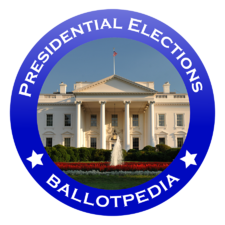Topics and participation in the PBS Democratic debate (February 2016)
Ballotpedia's scope changes periodically, and this article type is no longer actively created or maintained. If you would like to help our coverage grow, consider donating to Ballotpedia.
Ballotpedia's scope changes periodically, and this article type is no longer actively created or maintained. If you would like to help our coverage grow, consider donating to Ballotpedia.
Date: November 8, 2016 |
Winner: Donald Trump (R) Hillary Clinton (D) • Jill Stein (G) • Gary Johnson (L) • Vice presidential candidates |
Important dates • Nominating process • Ballotpedia's 2016 Battleground Poll • Polls • Debates • Presidential election by state • Ratings and scorecards |
2028 • 2024 • 2020 • 2016 Have you subscribed yet?
Join the hundreds of thousands of readers trusting Ballotpedia to keep them up to date with the latest political news. Sign up for the Daily Brew.
|
This article analyzes the central themes of the Democratic presidential debate held on February 11, 2016, in Milwaukee, Wisconsin. The transcript prepared by The Washington Post was used to measure candidate participation and audience engagement.[1] Footage from the debate was consulted where there were ambiguities in the text.
To compare the statistics of this debate to those of the previous Democratic debate, see the analysis of the MSNBC Democratic debate in February 2016.
Segments
Including opening and closing statements, the sixth Democratic presidential debate featured 17 unique discussion segments covering the scope of the federal government, race relations and national security. These discussion segments were measured by any shift in the theme of a discussion prompted by one of the moderators: Gwen Ifill and Judy Woodruff. The candidates also fielded questions from Facebook users.
- Opening statements
- Size of federal government and healthcare
- Cost of expanding federal government
- Women's issues
- Historic nature of Hillary Clinton's candidacy
- Incarceration rate of black Americans
- Race relations
- White Americans
- Immigration reform
- Federal assistance for senior citizens
- Campaign finance and Wall Street
- Reducing the size of the federal government
- National security
- Russia and Syria
- Syrian refugee crisis
- Influential leaders on foreign policy
- Closing statements
Ifill noted at the start of the debate, "With Iowa and New Hampshire behind us, we are now broadening the conversation to America's heartland and beyond, including here in Wisconsin."[1] The candidates barely discussed Wisconsin-specific issues, however. Only Clinton named the state in her contribution to the discussion segment on the incarceration rate of black Americans and her closing statement.
A recurring theme of the debate was President Barack Obama and the legacy of his administration. He was invoked in nearly three-fifths of the discussion segments for a total of 26 times. Donald Trump, the only Republican presidential candidate named in the debate, was also mentioned four times.
Overall participation
Participation in a discussion segment was defined as a substantive comment related to the discussion segment's topic. Jokes and attempts to gain permission from a moderator to speak were not considered participatory speech acts. In some instances, candidates who participated in a discussion segment diverted from the prompted topic.
This was the first Democratic debate where each candidate participated in every discussion segment.
Candidate participation by speaking order
This study also calculated the number of times a candidate spoke first, second or third during a discussion segment, whether prompted by a moderator with a question or invitation to rebut or by interjection.
In this debate, Sanders was prompted by a moderator to speak first in approximately 60 percent of the discussion segments. This was a deviation from the preceding four debates where Clinton spoke first as many times as or more than Sanders did.
Audience engagement
Audience engagement was measured by noting applause, cheering, or laughter in The Washington Post's transcript. Footage from the debate was consulted when the text was ambiguous about to whom the audience was responding.
For the fourth debate in a row, Sanders received more positive responses from the live audience than Clinton.
The discussion segment on national security produced the most audience engagement overall.
Candidate speech analysis
|
|
See also
- Presidential candidates, 2016
- Presidential election, 2016/Polls
- 2016 presidential candidate ratings and scorecards
- Presidential election, 2016/Straw polls
Footnotes
| |||||||||||





